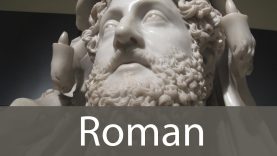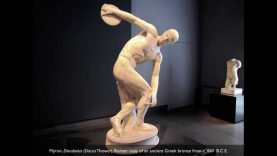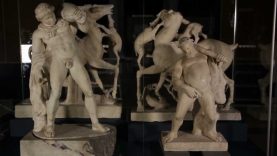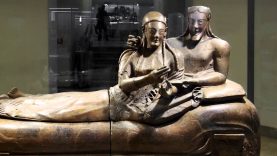Penthesilea bowl | Greek vase painting in practice | Τhe red figure technique
voice-over-script & subtitles (by Eleni Aloupi, EA/THETIS)
As Achilles looms over the falling Amazon and begins to deliver the mortal blow their eyes meet. The painter forces us to enter into the state of mind of the characters involved. Not only do his characters think, but they make us think too – qualities which perhaps constitute the essence of Early Classical Art.
This kylix depicting the slaying of the queen of Amazons Penthesilea by Achilles, was painted in a year between 470 and 460 BCE by an unknown vase painter at his studio near the center of Athens; most probably in the potter’s district of Kerameikos.
Today the unusually large kylix, known as the “Penthesilea bowl no 2688” forms part of the State Collections of Antiquities in Munich (Munich, Glyptothek and Antikensammlung).
We’ll follow the stages of production of a newly designed such kylix portraying the same scene in its tondo, which we were asked to reproduce for a private collection.
The first stage to produce a vase is the study of the design, details of decoration, calculation of its dimensions and proportions, requiring access to specialized libraries and databases.
Our vase-painter has produced a series of drawings and sketches before arriving at the final design which in itself has a special collectible value, completing and restoring the missing parts of the original image.
At the next stage we construct the vase body. In this case, we chose a large black glazed kylix of classical times.
The kylix was formed on the wheel in two parts, separately the cup and the stem, which were left to dry for 2 days before joining.
This is also the most vulnerable point of construction. As usual, we encountered failures that though discourage us, we learn from them and make us look at the original ancient vases for another perspective (and give us another perspective to the ancient vases)
To produce the ultra-fine clay slip, natural ferruginous clays from Attica are soaked in water and processed.
Specific knowledge is required both for the location of the clay deposit and for the preparation of the colloidal suspension from which the clay paint results. The preparation process lasts up to one week.
This stage is an important component of our know-how that has been acquired over the last 30 years through research, experimentation, and teamwork.
The areas that are going to become black are covered with the red clay paint. The vase goes through different hands as it was decorated by two vase painters, hand-drawn the main painting scene in its interior and the large exterior surface on the turn-table.
In the end, with an extra thin brush, the relief lines (those that are going to become intensely black) are added which give strength and integrity to the drawing.
Penthesilea’s scene is colorful and gilded with added pigments and embossed decorative elements with clay in the armor of the warriors (the cuirasses, leggings, swords and the spear) and the jewels wearing the Amazons.
The decorated cup is then placed in the kiln specially designed to perform the 3-stage firing as it was practiced by the ancients.
16 hours later, the red clay paint turns to the black glaze known for its velvet sheen and unsurpassed quality.
Gilding is applied after the firing, as in antiquity. The relief clay ornaments are covered with organic glue, and a then a golden metal sheet is placed on top and fixed with burnishing.
6 people worked in total to produce the vase and the materials used. The whole process lasted 7 weeks and it took us 9 hours to form the kylix on the wheel, 25 hours for decoration and 60 hours for firing. The work took place between October to November 2018.
source




















